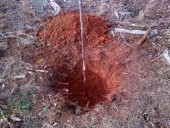
 9
9





 5
5




 1
1




-Nathanael
 5
5




 2
2




Invasive plants are Earth's way of insisting we notice her medicines. Stephen Herrod Buhner
Everyone learns what works by learning what doesn't work. Stephen Herrod Buhner
 1
1




Anne Miller wrote:
Why not experiment by mounding some of them with dirt to see what happens?
-Nathanael

 8
8




 4
4




 3
3




Joseph Lofthouse wrote:I visited many hundreds of farms in the last decade. The one's I like the best do not bury wood in the ground, they leave it laying on top. When I observe wood buried in the ground, I notice super low soil fertility, and plants struggling to survive. When I see wood laying on top of the ground, and not intermixed with soil, I observe thriving ecosystems.
In England, they showed me what they called "dead hedges". Basically an area, often between trees, where they piled the woody (and other) debris from the garden. They hosted an abundance of life: pollinators, predators to eat the slugs, wildflowers, fungi, etc.




Nothing ruins a neighborhood like paved roads and water lines.
 1
1




 2
2




-Nathanael

|
Think of how dumb the average person is. Mathematically, half of them are EVEN DUMBER. Smart tiny ad:
Play Your Way to a Sustainable Lifestyle: Uncover Permaculture Principles with Each Card
https://gardener-gift.com/
|





